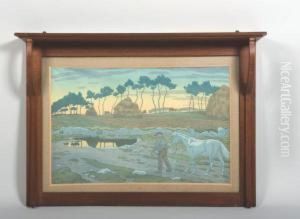Gustave Serrurier Bovy Paintings
Gustave Serrurier-Bovy was a prominent Belgian architect and furniture designer, born in Liège, Belgium, in 1858. He is considered one of the pioneers of the Art Nouveau movement, which swept through Europe at the end of the 19th century. His work is characterized by its innovative use of materials, incorporation of symbolic decoration, and the fusion of form and function, elements that were revolutionary in the realm of design and architecture at the time.
Serrurier-Bovy initially studied architecture at the Academy of Fine Arts in Liège before venturing to Paris, where he was exposed to the burgeoning Art Nouveau movement. This experience profoundly influenced his design aesthetic, leading him to explore new materials and techniques upon his return to Belgium. In 1884, he opened his own furniture workshop in Liège, where he began to experiment with creating pieces that broke away from the traditional styles of the time, integrating metalwork into wooden furniture and employing organic motifs that became signatures of the Art Nouveau movement.
Throughout the 1890s, Serrurier-Bovy's reputation grew, and his work began to gain international recognition. He participated in numerous exhibitions, including the 1900 Exposition Universelle in Paris, where his designs were celebrated for their innovation and artistic merit. His furniture designs often featured sinuous lines, intricate inlays, and the use of rare and exotic woods, which were sometimes combined with metal accents to create pieces that were both functional and deeply artistic.
Serrurier-Bovy was also a key figure in the development of the Art Nouveau architectural style in Belgium. He designed several buildings that embodied the movement's ideals, incorporating organic shapes and decorative elements that harmonized with their natural surroundings. His approach to architecture and design was holistic, considering not only the structural elements but also the interior decoration, furniture, and even the smallest details of a space to create a cohesive artistic vision.
Sadly, Gustave Serrurier-Bovy's career was cut short by his untimely death in 1910. Despite his relatively brief career, his contributions to the Art Nouveau movement have left a lasting legacy. His innovative use of materials, his approach to design as a synthesis of art and functionality, and his influence on both Belgian and international design make him a significant figure in the history of modern architecture and design.

